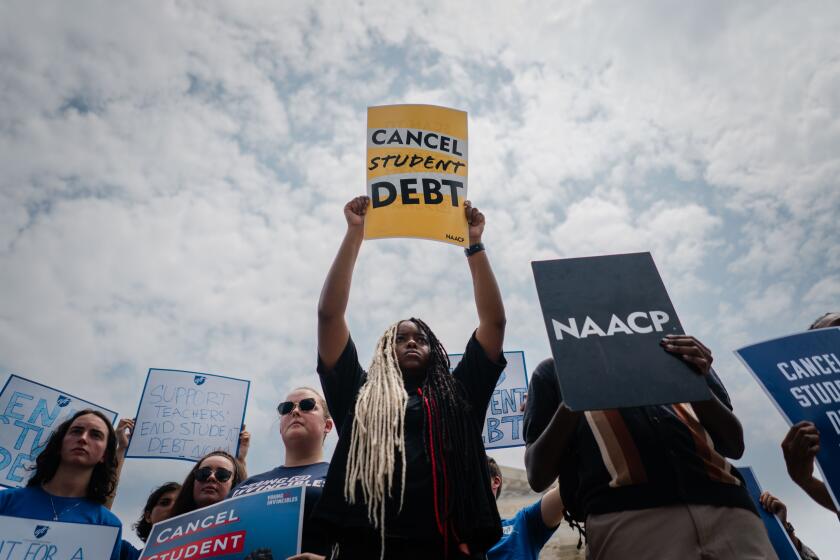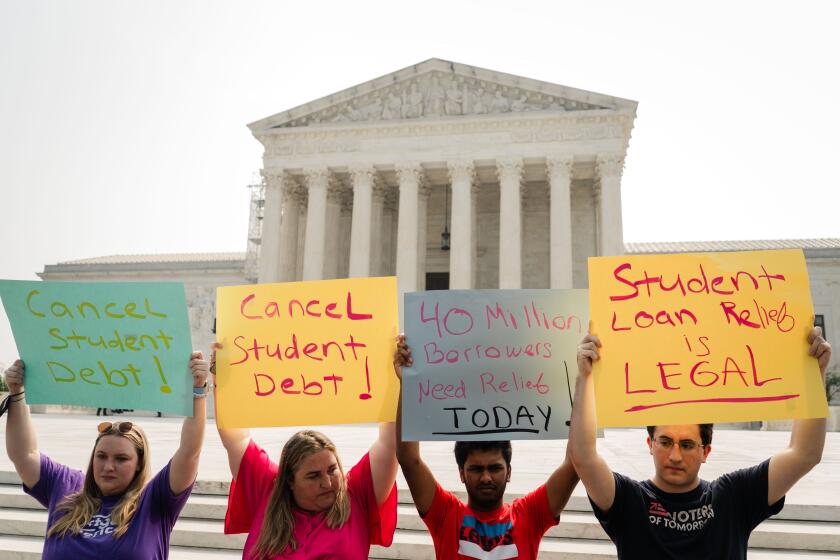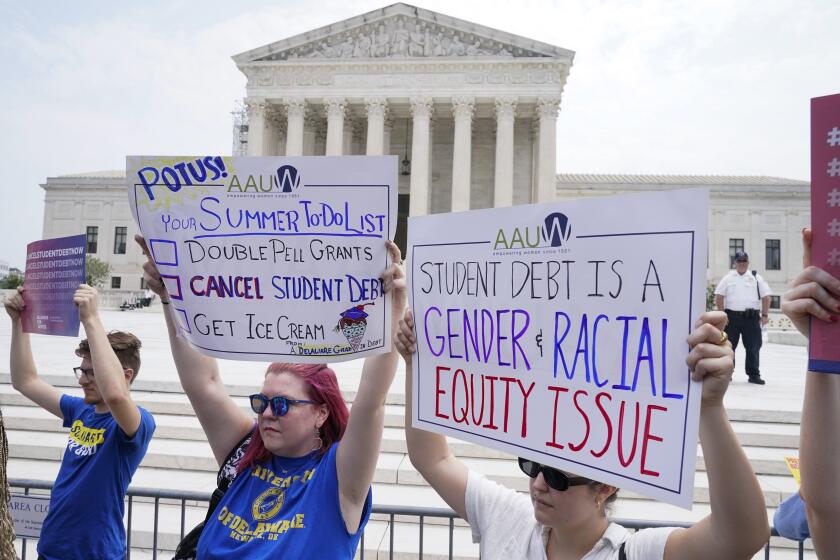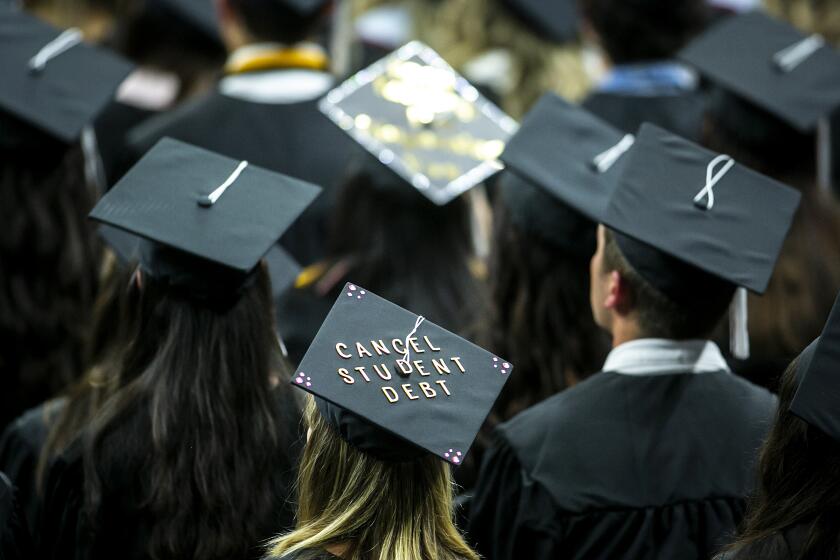Hollywood strike affecting your income? Here’s how to lower your student loan payments

- Share via
Striking Hollywood writers and actors are walking the picket lines, as are staffers at a shifting array of hotels across southern California. Those and other workers grappling with a sharp drop in income are increasingly worried about a new monthly bill due soon: student loan payments.
But advocates for borrowers say that the strike actually presents an opportunity for workers to slash their monthly payments, at least for federal student loans. And optional repayment plans from the Education Department, including a new one rolled out Tuesday by the Biden administration, can help on that front.
The bottom line is that anyone affected by a strike — those on picket lines and below-the-line-workers sidelined by the walkouts — can reduce or even eliminate their monthly payments while work is sparse. And if they act now, the changes can go into effect before their next payment is due in October.
Student loan holders are bracing for a double hit. Biden’s loan relief plan is blocked, and a years-long pandemic pause in payments ends in October.
What are the options for striking workers?
The standard student loan repayment plans work like a mortgage, with fixed monthly payments high enough to pay off the amount borrowed plus interest in 10 years (or, with an extended plans, 25 years). You can also sign up for a version that gradually increases the monthly payments, with a payback period of 10 to 25 years.
If you’re in a standard plan and your income plummets, you’re in a bind. That’s where the Education Department’s four “income-driven repayment” plans come in, which base your payments not on how much you owe, but how much you earn. And you can update your earnings, or “recertify,” at any point, as long as you do so at least once a year.
For workers in Hollywood and other industries affected by strikes, “this is the perfect time to recertify,” said Natalia Abrams, president of the nonprofit Student Debt Crisis Center. Abrams said she has counseled many borrowers to recertify when their earnings drop, whether it’s because they’re between gigs, they lose their job or some other forces undercut their income.
Jackie Filson, a spokesperson for the nonprofit Student Borrower Protection Center, said an income-driven plan is available even if your income could rebound at any moment. “The Income-Driven Repayment application only cares about your current income, not your past income or the likelihood that you will earn more money if and when a strike resolves,” she said in an email.
The Biden administration has forgiven billions in federal student loans by improving the current safety net available to borrowers.
What would my payment be under an income-driven plan?
Under an income-driven plan, your monthly payment will be 10% of your discretionary income, which for most plans is any amount over 150% of the federal poverty level. This translates to $21,870 for a single individual or $45,000 for a family of four. But under the new Saving on a Valuable Education plan launched Tuesday, your monthly payment will be 10% of your income over 225% of the federal poverty level.
“A single, unmarried striking worker is eligible for a $0 payment under any Income-Driven Repayment plan, assuming they have no other sources of income while on strike,” Filson added. “It doesn’t matter what type of federal student loan they have, they are eligible to request an IDR plan that will result in a $0 monthly payment. Of course, married striking workers need to consider their spouse’s income if they file their taxes jointly, but for a single person on strike this is straightforward — they have no earnings so they don’t need to pay.”
In fact, anyone earning less than about $32,800 would qualify for a monthly payment of $0 under the SAVE plan. The Biden administration estimates that more than 1 million borrowers fall into that category.
Your payment will depend not only on your income, but also your marital status and number of dependents. You’ll have to recertify your income, marital status and dependents at least once a year with the Education Department.
A new, income-based student loan repayment plan launched Tuesday offers more affordable monthly payments to millions of low- and moderate-income borrowers.
How do I prove that my income dropped?
If you don’t have any income, you can submit a signed statement saying so — you don’t have to provide proof, Filson said. The Education Department warns that lying about your income could result in criminal penalties, including a prison term.
The statement has to include your estimated yearly gross income; if your income is currently $0, then your estimate can be $0. But if you’re married, the estimate must include your spouse’s income, either combined with yours, if you file taxes jointly, or on its own, if you file taxes separately.
Applications can become more complicated if you — or your spouse, if you file taxes jointly — are still working, whether in a temporary gig, a side hustle or a fledgling business you started to scrape by during the strike. If you want to back up your estimate with documentation, you could provide a paystub or a letter from your employer that is not older than 90 days. Your estimate will need to include all taxable earnings, such as tips, alimony and unemployment benefits.
Or you could just submit a signed statement with an estimate of your yearly gross income, as described above. The self-certification option was added during the pandemic, so it’s likely to go away in a few months, said Michele Shepard, senior director of college affordability for the Institute for College Access & Success.
What do I do if my income goes back up?
Once you’ve certified the drop in income, Abrams of the Student Debt Crisis Center said, there’s no obligation to let the department or the company servicing your loan know when you go back to work, win the lottery or find another lucrative source of income. You’ll have your current monthly payment amount for a year, she said, until it’s time to recertify your income and family status.
Now that the Supreme Court has struck down President Biden’s loan forgiveness plan, companies are looking to offer student debt repayment as a benefit.
What are the tradeoffs of changing plans?
Switching from a standard plan to an income-driven one for your federal loans means you will no longer be paying off your debt on a set schedule, said Shepard of TICAS, a nonprofit. Instead, you’ll make payments for up to 20 or 25 years, depending on the size and type of your loan(s) and the repayment plan. If any balance remains after you’ve made the required number of monthly payments, it will be canceled.
The months that you spent making payments under the standard plan will be counted toward the required number in the income-driven plan. So will the months during the pandemic when you made no payments on your federal loans because none were required.
The SAVE plan offers a couple of other advantages. Next July, the required monthly payment will drop from 10% to 5% of your disposable income. And if you stay current on your SAVE payments, even if they’re too low to cover the interest that accrued, that interest won’t accumulate or be added to your loan balance — instead, the department will simply wipe it off the books.
That makes SAVE an attractive option even for borrowers whose incomes haven’t dropped, Shepard said. “Everyone from a self-interest standpoint should enroll in the SAVE plan,” she said. “There are very few borrowers who might pay more monthly or might pay more over time.”
Still, because you’ll be paying off your loan over a longer period, income-driven plans may cause you to pay more in interest than you would under a standard plan, the Education Department says. And the amount of debt forgiven after 20 to 25 years may be considered income that you’ll have to pay taxes on.
The “hot strike summer” is prompting California lawmakers to introduce last-minute legislation to help workers.
How do I sign up for an income-driven plan?
You can apply by filling out a virtual application at studentaid.gov/idr/. If you’d prefer to obtain a form that you could mail in, contact the company servicing your loan.
You’ll need to decide whether to give the department access to your IRS records to make an initial determination of your income, then recertify it every year. Failing to recertify your income every 12 months will put you back into a standard plan until you apply again for an income-based one.
About The Times Utility Journalism Team
This article is from The Times’ Utility Journalism Team. Our mission is to be essential to the lives of Southern Californians by publishing information that solves problems, answers questions and helps with decision making. We serve audiences in and around Los Angeles — including current Times subscribers and diverse communities that haven’t historically had their needs met by our coverage.
How can we be useful to you and your community? Email utility (at) latimes.com or one of our journalists: Jon Healey, Ada Tseng, Jessica Roy and Karen Garcia.
More to Read
Inside the business of entertainment
The Wide Shot brings you news, analysis and insights on everything from streaming wars to production — and what it all means for the future.
You may occasionally receive promotional content from the Los Angeles Times.
















